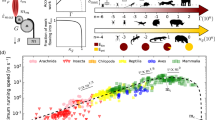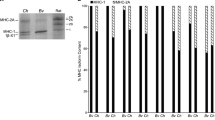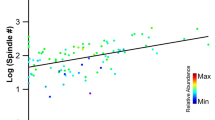Abstract
To fully understand the effect of scaling on skeletal muscle shortening velocity (V 0), it is important to know which phenotypic characteristics drive the changes between species. The purpose of the current investigation was to compare the effects of body mass and femur length, as an estimate of total limb length, on V 0 in species that cover a 100,000-fold range of body masses. Using the slack test procedure, V 0 was determined for fibers expressing types I and IIa myosin heavy chain (MyHC) isoforms in the mouse, rat, dog, human, horse, and rhinoceros under identical experimental conditions. A significant scaling effect on V 0 was detected when compared to body mass (type I fibers, r=0.95, p<0.01; type IIa fibers, r=0.83, p<0.05). However, the horse’s V 0 for both fiber types was faster than the human’s, despite having a 5-fold greater body mass than the human. When V 0 was scaled vs limb length, the strength of the relationships improved in fibers expressing both types I and IIa MyHC (r=0.98, p<0.001, and r=0.89, p<0.05, respectively) and scaled with the expected relationship, with the species with the shorter femur, the horse, having the faster V 0. A similar effect can be seen with stride frequency scaling more closely with limb length than body mass. These results suggest that limb length, not body mass, is a more relevant factor driving the scaling effect on skeletal muscle shortening velocity.



Similar content being viewed by others
References
Alexander RM, Jayes AS, Maloiy GMO, Wathuta EM (1979) Allometry of the limb bones of mammals from shrews (Sorex) to elephant (Loxondonta). J Zool (Lond) 189:305–314
Alexander RM, Jayes AS, Maloiy GMO, Wathuta EM (1981) Allometry of the leg muscles of mammals. J Zool (Lond) 194:539–522
Andruchov O, Andruchova O, Wang Y, Galler S (2004) Kinetic properties of myosin heavy chain isoforms in mouse skeletal muscle: comparison with rat, rabbit, and human and correlation with amino acid sequence. Am J Physiol Cell Physiol 287:C1725–C1732
Avogadro P, Dolenec A, Belli A (2003) Changes in mechanical work during severe exhausting running. Eur J Appl Physiol 90:165–170
Azbel MY (1994) Universal biological scaling and mortality. Proc Natl Acad Sci U S A 91(26):12453–12457
Barany M (1967) ATPase activity of myosin correlated with speed of muscle shortening. J Gen Physiol 50(Suppl 6):197–218
Christiansen P (1999) Scaling of the limb long bones to body mass in terrestrial mammals. J Morphol 239(2):167–190
Clark AJ (1927) Comparative physiology of the heart. Cambridge University Press, London
de Jong WW, Zweers A, Cohen LH (1978) Influence of single amino acid substitutions on electrophoretic mobility of sodium dodecyl sulfate-protein complexes. Biochem Biophys Res Commun 82(2):532–539
Fedak MA, Seeherman HJ (1979) Reappraisal of energetics of locomotion shows identical cost in bipeds and quadrupeds including ostrich and horse. Nature 282(5740):713–716
Felsenstein J (1985) Phylogenies and the comparative method. Am Nat 125(1):1–15
Ford LE (1984) Some consequences of body size. Am J Physiol 247(4 Pt 2):H495–H507
Frontera WR, Larsson L (1997) Contractile studies of single human skeletal muscle fibers: a comparison of different muscles, permeabilization procedures, and storage techniques. Muscle Nerve 20(8):948–952
Galler S, Hilber K (1994) Unloaded shortening velocity of skinned mammalian skeletal muscle fibres: effects of the experimental approach and passive force. J Muscle Res Cell Motil 15(4):400–412
Giulian GG, Moss RL, Greaser M (1983) Improved methodology for analysis and quantitation of proteins on one- dimensional silver-stained slab gels. Anal Biochem 129(2):277–287
Gordon AM, Homsher E, Regnier M (2000) Regulation of contraction in striated muscle. Physiol Rev 80(2):853–924
Greaser ML, Moss RL, Reiser PJ (1988) Variations in contractile properties of rabbit single muscle fibres in relation to troponin T isoforms and myosin light chains. J Physiol (Lond) 406:85–98
Heglund NC, Taylor CR, McMahon TA (1974) Scaling stride frequency and gait to animal size: mice to horses. Science 186(4169):1112–1113
Hill AV (1950) The dimensions of animals and their muscular dynamics. Science 38:209–230
Hook P, Sriramoju V, Larsson L (2001) Effects of aging on actin sliding speed on myosin from single skeletal muscle cells of mice, rats, and humans. Am J Physiol Cell Physiol 280(4):C782–C788
Iriate-Diaz J (2002) Differential scaling of locomotor performance in small and large terrestial mammals. J Exp Biol 205:2897–2908
Jurgens KD (2002) Eutruscan shrew muscle: the consequences of being small. J Exp Biol 205:2161–2166
Knight B (1996) Forensic pathology. 2nd edn. Arnold, London
Kram R, Taylor CR (1990) Energetics of running: a new perspective. Nature 346:265–276
Larsson L, Moss RL (1993) Maximum velocity of shortening in relation to myosin isoform composition in single fibres from human skeletal muscles. J Physiol (Lond) 472:595–614
Larsson L, Li X, Tollback A, Grimby L (1995) Contractile properties in single muscle fibres from chronically overused motor units in relation to motoneuron firing properties in prior polio patients. J Neurol Sci 132(2):182–192
Larsson L, Li X, Frontera WR (1997) Effects of aging on shortening velocity and myosin isoform composition in single human skeletal muscle cells. Am J Physiol 272(2 Pt 1):C638–C649
Larsson L, Li X, Yu F, Degens H (1997) Age-related changes in contractile properties and expression of myosin isoforms in single skeletal muscle cells. Muscle Nerve Suppl 5(8):S74–S78
Larsson L, Li X, Edstrom L, Eriksson LI, Zackrisson H, Argentini C, Schiaffino S (2000) Acute quadriplegia and loss of muscle myosin in patients treated with nondepolarizing neuromuscular blocking agents and corticosteroids: mechanisms at the cellular and molecular levels (see comments). Crit Care Med 28(1):34–45
Levine RJ, Yang Z, Epstein ND, Fananapazir L, Stull JT, Sweeney HL (1998) Structural and functional responses of mammalian thick filaments to alterations in myosin regulatory light chains. J Struct Biol 122(1–2):149–161
Lindstedt SL, Hoppeler H, Bard KM, Thronson HA Jr (1985) Estimate of muscle-shortening rate during locomotion. Am J Physiol 249:R699–R703
Lindstedt SL, McGlothlin T, Percy E, Pifer J (1998) Task-specific design of skeletal muscle: balancing muscle structural composition. Comp Biochem Physiol B Biochem Mol Biol 120(1):35–40
McMahon TA (1975) Using body size to understand the structural design of animals: quadrupedal locomotion. J Appl Physiol 39(4):619–627
Medler S (2002) Comparative trends in shortening velocity and force production in skeletal muscles. Am J Physiol Regul Integr Comp Physiol 283:R368–R378
Mercer JA, Vance J, Hreljac A, Hamill J (2002) Relationship between shock attenuation and stride length during running at different velocities. Eur J Appl Physiol 87:403–408
Morano I (1999) Tuning the human heart molecular motors by myosin light chains. J Mol Med 77(7):544–555
Moss RL (1979) Sarcomere length-tension relations of frog skinned muscle fibres during calcium activation at short lengths. J Physiol (Lond) 292:177–192
Pellegrino M, Canepari M, Rossi R, D’Antona G, Reggiani C, Bottinelli R (2003) Orthologous myosin isoforms and scaling of shortening velocity with body size in mouse, rat, rabbit, and human muscles. J Physiol 546(3):677–689
Rall J (1985) Energetic aspects of skeletal muscle contraction: implications of fiber type. Exerc Sport Sci Rev 13:33–74
Roberts TJ, Chen MS, Taylor R (1998) Energetics of bipedal running II. Limb design and running mechanics. J Exp Biol 201:2753–2762
Roberts TJ, Kram R, Weyand PG, Taylor R (1998) Energetics of bipedal running I. Metabolic cost of generating force. J Exp Biol 201:2745–2751
Rome LC (1992) Scaling of muscle fibres and locomotion. J Exp Biol 168:243–252
Rome LC, Sosnicki AA, Goble DO (1990) Maximum velocity of shortening of three fibre types from horse soleus muscle: implications for scaling with body size. J Physiol (Lond) 431:173–185
Roy RR, Graham S, Peterson JA (1988) Fiber type composition of the plantarflexors of giraffes (Giraffa camelopardalis) at different postnatal stages of development. Comp Biochem Physiol A 91A(2):347–352
Satta A, Migliori GB, Spanevello A, Neri M, Bottinelli R, Canepari M, Pellegrino MA, Reggiani C (1997) Fibre types in skeletal muscles of chronic obstructive pulmonary disease patients related to respiratory function and exercise tolerance. Eur Respir J 10(12):2853–2860
Schiaffino S, Reggiani C (1996) Molecular diversity of myofibrillar proteins: gene regulation and functional significance. Physiol Rev 76(2):371–423
Schmidt-Nielsen K (1984) Scaling: why is animal size so important? Cambridge University Press, Cambridge
Seow CY, Ford LE (1991) Shortening velocity and power output of skinned muscle fibers from mammals having a 25,000-fold range of body mass. J Gen Physiol 97(3):541–560
Serrano AL, Petrie JL, Rivero JL, Hermanson JW (1996) Myosin isoforms and muscle fiber characteristics in equine gluteus medius muscle. Anat Rec 244:444–451
Stephenson GM (2001) Hybrid skeletal muscle fibers: a rare or common phenomenon? Clin Exp Pharmacol Physiol 28:692–702
Sweeney HL, Feng HS, Yang Z, Watkins H (1998) Functional analyses of troponin T mutations that cause hypertrophic cardiomyopathy: insights into disease pathogenesis and troponin function. Proc Natl Acad Sci U S A 95(24):14406–14410
Taylor CR, Rowntree VJ (1973) Running on two or on four legs: which consumes more energy? Science 179:186–187
Taylor CR, Heglund NC, Maloiy GMO (1982) Energetics and mechanics of terrestial locomotion. I. Metabolic energy consumption as a function of speed and body size in birds and mammals. J Exp Biol 97:1–21
Toniolo L, Patruno M, Maccatrozzo L, Pellegrino M, Canepari M, Rossi R, D’Antona G, Bottinelli R, Reggiani C, Mascarello F (2004) Fast fibers in a large animal: fibre types, contractile properties and myosin expression in pig skeletal muscles. J Exp Biol 207:1875–1886
Weiss A, Leinwand LA (1996) The mammalian myosin heavy chain gene family. Annu Rev Cell Dev Biol 12:417–439
Widrick JJ, Romatowski JG, Karhanek M, Fitts RH (1997) Contractile properties of rat, rhesus monkey, and human type I muscle fibers. Am J Physiol 272(1 Pt 2):R34–R42
Acknowledgements
We would like to thank Dr. Robert Gilmour and “The Wilds” Zoo in Cumberland, Ohio for their role in providing muscle tissue for this investigation and Dr. John Hermanson for providing bones for analysis. We would also like to thank Parinaz Pircher, Cathy Vandenberg, and Ausra Lionikas for the analysis of gel electrophoresis. This study was supported by grants from the NIAMS (AR08603, AR45627, AR47318) and the Swedish Research Council (8651).
Author information
Authors and Affiliations
Corresponding author
Rights and permissions
About this article
Cite this article
Marx, J.O., Olsson, M.C. & Larsson, L. Scaling of skeletal muscle shortening velocity in mammals representing a 100,000-fold difference in body size. Pflugers Arch - Eur J Physiol 452, 222–230 (2006). https://doi.org/10.1007/s00424-005-0017-6
Received:
Revised:
Accepted:
Published:
Issue Date:
DOI: https://doi.org/10.1007/s00424-005-0017-6




